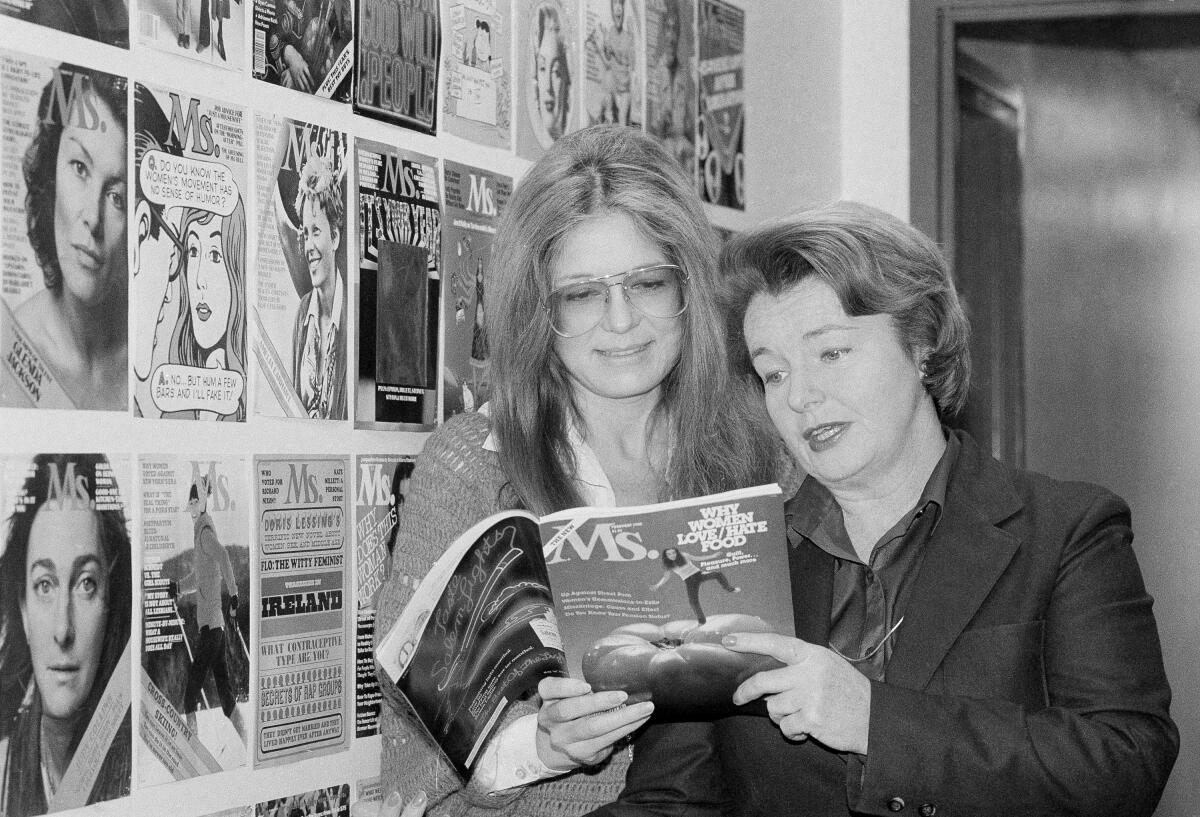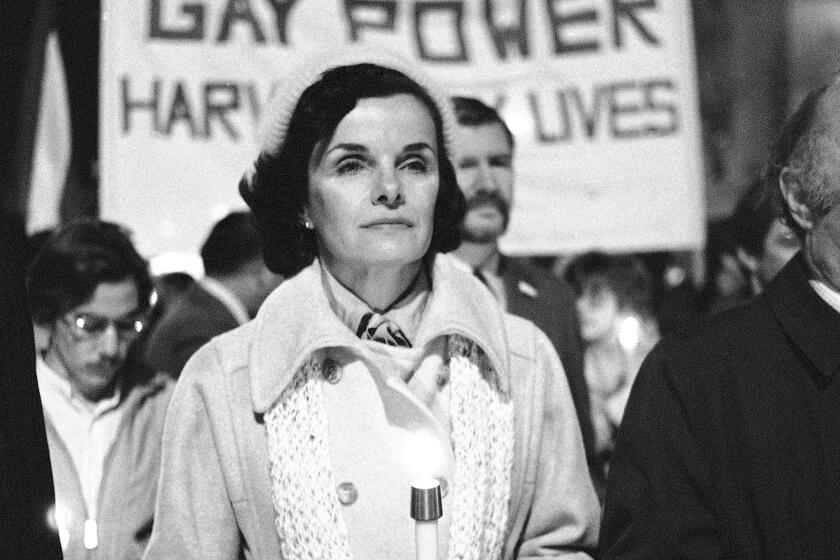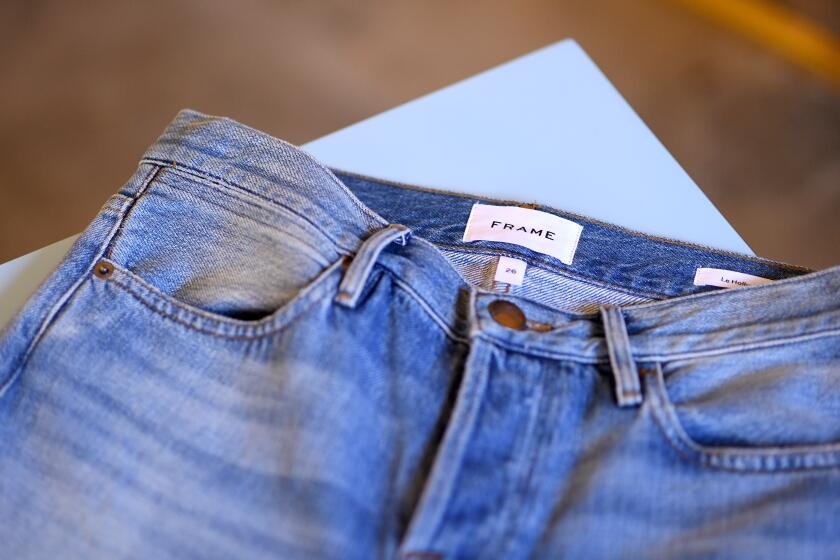Column: 50 years after Ms. magazine’s debut, why is the patriarchy still alive and well?

- Share via
Who would have thought, back when the women’s media landscape was dominated by Ladies’ Home Journal and Good Housekeeping, that a magazine born of the second great American feminist wave would be around 50 years later?
Certainly not the late Harry Reasoner, who, as the anchor for ABC Evening News, personified the white male media establishment.
“After you’ve done marriage contracts, role-changing, female identity crisis, what do you do next? Organize foods for Christmas dinner, I expect,” proclaimed Reasoner after paging through the first issue of Ms. magazine in 1972.
Five years later, his portrait appeared in a full-page New York Times ad celebrating Ms.’ fifth anniversary. You couldn’t see the egg on his face, but it was there all the same:
“Ms. Magazine has shown us all — through personal writing, humor, political theory and first-class exposé journalism — that there is literally no subject feminism does not affect or transform,” he wrote.
Amen, Brother Harry.
A new anti-gay-marriage push, energized by the overturning of abortion rights, is trying to make Americans believe the institution of marriage is diminished by same-sex unions.
That ad was reproduced in a compulsively readable and entertaining new compendium, “50 Years of Ms.: The Best of the Pathfinding Magazine That Ignited a Revolution,” a 500-page, lavishly illustrated anthology with a hot pink cover, edited by Katherine Spillar, an unsung pillar of contemporary American feminism who is both the magazine’s executive editor and co-founder and executive director of the Feminist Majority Foundation. The foundation took ownership of Ms. in 2001 when it was flailing financially and in danger of going under. The organization’s leadership was dubious, but Ms. co-founder Gloria Steinem was insistent.
It finally dawned on Eleanor Smeal and her foundation co-founder, the late Peg Yorkin, that the fate of Ms. was entirely in their hands. “We’re not gonna let them close Ms. magazine,” Smeal recalled thinking during a panel discussion at the Hammer Museum on Thursday celebrating the book’s publication. “It wouldn’t look good for the feminist movement!” (She was joined onstage by Spillar, civil rights activist Dolores Huerta, feminist legal scholar and writer Michelle Goodwin and feminist writer Carmen Rios.)
They had come to celebrate Ms., which has been at the forefront of defining and exploring women’s lives in ways that mainstream media did not, or would not.
The first female California senator made a profound mark embracing progressive causes such as an assault weapons ban and damning the CIA’s use of torture.
In August 1976, for example, almost two decades before Congress passed the Violence Against Women Act, Ms. featured a shocking closeup of a woman with a black eye for its cover story, “Battered Wives: Help for the Secret Victim Next Door.”
Whether the topic was date rape, workplace sexual harassment, divorce, female genital mutilation or even the politics of housework, Ms. was usually well ahead of everything else on the newsstands.
In its first “preview issue” cover story, “Click! The Housewife’s Moment of Truth,” by Jane O’Reilly, Ms. introduced the concept of seemingly minor moments that lead to feminist revelations. “A friend of mine stood and watched her husband step over a pile of toys on the stairs,” wrote O’Reilly. “ ’Why can’t you get this stuff put away?’ he mumbled. Click! ‘You have two hands,’ she said, turning away.”
As I leafed through the anniversary book, I expected to be struck by how much things have changed in the past half-century.
Instead, I was chilled by how much things have stayed the same.
Plus-size influencers and a new novel set in Paris are an antidote to Fashion Week’s body-shaming parades
In the first issue, for instance, 53 prominent women, including Billie Jean King, Nora Ephron, Judy Collins and Anaïs Nin, signed a declaration saying “We Have Had Abortions.” The following year, the Supreme Court affirmed a woman’s right to choose in its historic Roe vs. Wade decision. Ever since, Ms. has chronicled the fights over abortion rights, helping readers understand that outlawing the procedure is patriarchy in action, aimed at controlling women’s bodies in order to deny them autonomy over their very lives. (As the people at Ms. like to say, if you’d been reading Ms. you would not have been the least bit surprised by the Dobbs decision, which overturned Roe last year.)
A charming 1972 children’s story by the late Lois Gould, about a baby named X whose parents refused to gender it (and yes, Gould used “it”), presages the current right-wing hysteria over gender identity.
We’re used to men involved in sexual scandals, but women are proving that they, too, have lousy judgment.
Alan Alda parodied the self-help movement in “Testosterone Poisoning,” as pointed today as it was in 1975. He offered men a “simple test” to check for danger signs:
“When someone tries to pass you on the highway, do you speed up?”
“Would you like to watch a sunset with a friend and feel at one with nature and each other, or would you rather take apart a clock?”
In 1981, long before the phrase “mansplaining” made it into the popular lexicon, Ms. published “The Politics of Talking,” by Barbara Ehrenreich, who wrote about the “conversational mismatch” between men and women. “Men can and will talk,” she wrote, “if they can set the terms.”
In October 1985, Marie Shear wrote about “The Great Pronoun Debate.”
My niece was shocked when I spent $200 on made-in-L.A. jeans. She buys online from Chinese fast-fashion giant Shein, where jeans cost $10.
And then there are the pieces that provide an infuriating trip down memory lane.
“Welfare is a Women’s Issue,” a 1972 piece by Johnnie Tillmon, began, “Welfare is like a super-sexist marriage. You trade in a man for the man. … He tells you what to buy, what not to buy, where to buy it, and how much things cost. If things — rent, for instance — really cost more than he says they do, it’s just too bad. He’s always right.”
In June 1975, Angela Davis wrote about an incarcerated Black woman, Joan Little, who killed a white prison guard in North Carolina with the ice pick he brought into her cell. She acted in self-defense, she said, after he raped her. He was found shoeless and pantless in her cell, with semen on his thigh. Little, who was charged with first-degree murder, became the subject of a national outcry against sexual violence and was acquitted that August.
In September 1976, Lindsy Van Gelder wrote about a lesbian mother, Mary Jo Risher, who lost her court fight to keep custody of her son. Even though she was a good mother, and the boy’s father had been in legal scrapes and once broke Risher’s nose during an argument, the jury foreman said, “I felt the heterosexual family would be better for this child.”
The most recent piece in the anthology was published in spring 2022. “The Patriarchs’ War on Women,’’ by Harvard political scientists Zoe Marks and Erica Chenoweth, is about the rise of autocrats around the world and the relationship between authoritarianism and sexism, racism and homophobia.
The title may sound like a call to arms from the 1970s, but it is all too depressingly current.
Ms. magazine may have lost its ability to shock, but now well into middle age, it has lost none of its relevance.
More to Read
A cure for the common opinion
Get thought-provoking perspectives with our weekly newsletter.
You may occasionally receive promotional content from the Los Angeles Times.

















